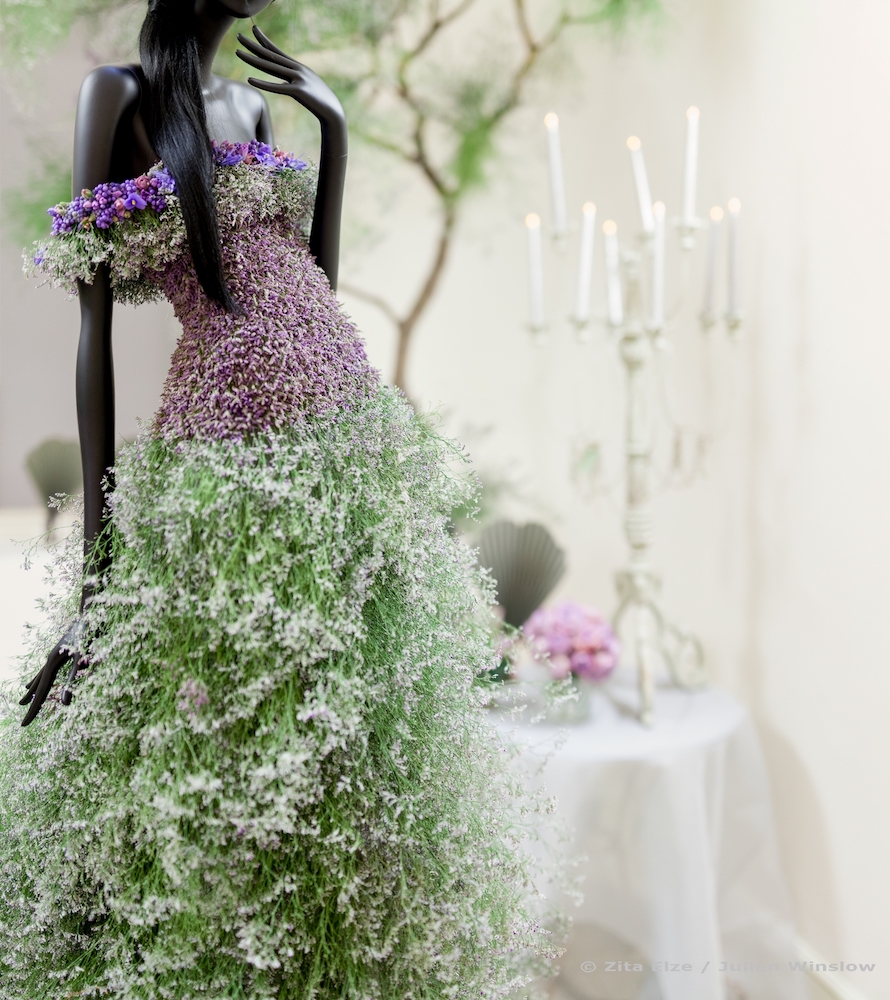On the 20th and 21st of January this year, the annual Aashni + Co Wedding Show came to the West Wing of Somerset House. The event featured hundreds of breathtaking South Asian couture dresses and jewellery for brides, made by worldwide famous designers such as Sabyasachi, Gaurav Gupta and Tarun Tahiliani.
The Kew Gardens based floral artist Zita Elze was in charge of the floral design for the event, and transformed the rooms of the West Wing into magical scenes. Her flower arrangements were not only placed and draped across the architecture of the building, but also acted as fashion pieces in themselves. In one of the main rooms, Zita created a spectacular handmade fresh flower dress, inspired by Cinderella. As Zita said, “I didn’t want to create another blonde Cinderella so I sourced an elegant mannequin which also alluded to my country of origin Brazil, which has a whole rainbow of ethnic references. The design itself emerged from seasonally available blooms.” Its long and flowing skirt was embellished with sea lavender and the fitted bodice was off-the-shoulder, embroidered with tiny flowerheads. The natural pastel colours subtly altered depending on the texture and shape of each part of the dress.

Zita’s dress was displayed on a gracefully posed mannequin, which took centre stage at the end of a dramatic flower arch lined corridor. There were other floral displays within the space, providing a backdrop for the mannequin and the ethereal dress. In the evening, LED lights enhanced the colours of the flowers on the dress, contrasting with its natural appearance in daylight. At the opposite end of the wing on the Nelson staircase, Zita hung one hundred Cinderella-like shoes from the railings, as well as petal garlands. The shoes were filled with fresh flowers, and created spectacular shadows on the staircase thanks to the lighting. Zita had decorated many of the couture designers’ exhibition rooms, enhancing their dress designs. One area dedicated to jewellery featured a chandelier tree as a centrepiece, which one could walk around whilst viewing the precious accessories in the surrounding cabinets.

Zita has previously created handmade flower dresses for clients and events, and regularly crosses into the realm of fashion. Although not formally trained in fashion, she has a keen sensitivity when working with the human form and designing gowns. Each piece is unique. When creating a dress, Zita notes that she first “creates a textile base, then when the base is ready I apply my floral embroidery technique. This process normally takes a week, all by hand. In this case, I started with the train and then worked on the bodice during the last two days – so that the bodice was kept fresh throughout the exhibition. This is less important when working on a wedding dress which will only be used on the actual day.” Zita also designs accessories made out of real flowers such as veils, hair pieces, bags, parasols and jewellery. Although the materials she uses have a limited lifetime, there is still a beauty to her works once they have dried. The most interesting aspect of her flower dresses is this notion of temporality, and the way in which they gradually change colour and texture as they age.
By Grace Lee
Zita Elze’s shop and design academy are located on 287 and 303 Sandycombe road in Kew, Surrey. Make sure to visit!
All photographs taken by Julian Winslow








